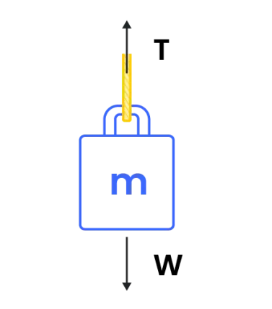1. What is the Tension Calculator?
Definition: This calculator determines the tension forces in ropes or strings for objects either hanging or being pulled on a frictionless surface.
Purpose: It helps students, engineers, and physicists analyze tension forces in mechanical systems, useful for designing structures, studying motion, and understanding equilibrium.
2. How Does the Tension Calculator Work?
The calculator applies Newton’s Second Law (\( F = ma \)) to compute tension forces, using SI units internally (kg, N) and converting to the selected output unit:
Hanging (1 Rope):
\( T = mg \)
Hanging (2 Ropes):
\( T_1 \cos(\alpha) = T_2 \cos(\beta), \quad T_1 \sin(\alpha) + T_2 \sin(\beta) = mg \)
Where:
- \( T, T_1, T_2 \): Tension forces (N or lbf)
- \( m \): Mass of object(s) (kg, g, or lb)
- \( g \): Gravitational acceleration (9.81 m/s²)
- \( \alpha, \beta, \theta \): Angles from horizontal (degrees)
- \( F \): Pulling force (N or lbf)
- \( a \): System acceleration (m/s²)
Steps:
- Select the scenario: hanging or pulling on a frictionless surface.
- Specify the number of ropes (hanging) or objects (pulling).
- Enter masses, angles, pulling force, and their units.
- Convert inputs to SI units (kg, N), compute tensions, then convert outputs to the selected unit (N or lbf).
- Display tensions as decimals, formatted in scientific notation if the absolute value is less than 0.001 or greater than 10000, otherwise with 4 decimal places.
3. Importance of Tension Calculation
Tension calculations are crucial for:
- Physics Education: Understanding force balances and equilibrium.
- Engineering Design: Ensuring ropes, cables, and structures can withstand loads.
- Construction Safety: Preventing failures in cranes, bridges, and scaffolding.
- Mechanical Systems: Analyzing motion in pulley systems or towed objects.
4. Using the Calculator
Example 1 (Hanging, 1 Rope): Calculate tension for an object hanging from one rope:
- Scenario: Hanging
- Ropes: 1
- Mass: \( m = 5 \, \text{kg} \)
- Tension Unit: N
- Calculation: \( T = 5 \times 9.81 = 49.05 \, \text{N} \)
- Image Displayed: tension_hanging_1rope.png
- Result: Tension (T) = 49.0500 N
Example 2 (Hanging, 2 Ropes): Calculate tensions for an object hanging from two ropes:
- Scenario: Hanging
- Ropes: 2
- Mass: \( m = 10 \, \text{kg} \)
- Angle α: 30°
- Angle β: 60°
- Tension Unit: lbf
- Calculation:
- Weight: \( mg = 10 \times 9.81 = 98.1 \, \text{N} \)
- \( T_2 = \frac{98.1 \cos(30^\circ)}{\sin(30^\circ) \cos(60^\circ) + \sin(60^\circ) \cos(30^\circ)} = \frac{98.1 \times \frac{\sqrt{3}}{2}}{\frac{1}{2} \times \frac{1}{2} + \frac{\sqrt{3}}{2} \times \frac{\sqrt{3}}{2}} = 169.7413 \, \text{N} \)
- \( T_1 = T_2 \frac{\cos(60^\circ)}{\cos(30^\circ)} = 169.7413 \times \frac{\frac{1}{2}}{\frac{\sqrt{3}}{2}} = 98.1 \, \text{N} \)
- Convert to lbf: \( T_1 = 98.1 \times 0.224809 \approx 22.0538 \, \text{lbf} \), \( T_2 = 169.7413 \times 0.224809 \approx 38.1557 \, \text{lbf} \)
- Image Displayed: tension_hanging_2ropes.png
- Results:
- Tension 1 (T₁) = 22.0538 lbf
- Tension 2 (T₂) = 38.1557 lbf
Example 3 (Pulling, 2 Objects): Calculate tension for two objects pulled on a frictionless surface:
- Scenario: Pulling
- Objects: 2
- Mass 1: \( m_1 = 5000 \, \text{g} = 5 \, \text{kg} \)
- Mass 2: \( m_2 = 3 \, \text{kg} \)
- Pulling Force: \( F = 16 \, \text{N} \)
- Angle θ: 0°
- Tension Unit: N
- Calculation:
- Acceleration: \( a = \frac{16 \cos(0^\circ)}{5 + 3} = 2 \, \text{m/s}^2 \)
- Tension: \( T_1 = 3 \times 2 = 6 \, \text{N} \)
- Image Displayed: tension_pulling_2objects.png
- Result: Tension 1 (T₁) = 6.0000 N
5. Frequently Asked Questions (FAQ)
Q: What units can I use for inputs?
A: Mass can be in kg, g, or lb; pulling force can be in N or lbf. The calculator converts all inputs to SI units (kg, N) for calculations.
Q: Why do I get an error for zero mass or force?
A: Masses and forces must be positive to produce physically meaningful tension forces.
Q: How are angles handled?
A: Angles are input in degrees and converted to radians for calculations.
Q: Can I change the output unit for tension?
A: Yes, you can select N or lbf for tension outputs, and the calculator will convert accordingly.
Q: Why does the image change?
A: The image updates to reflect the specific configuration (e.g., number of ropes or objects) you select, providing a visual representation of the scenario.
 Home
Home
 Back
Back
